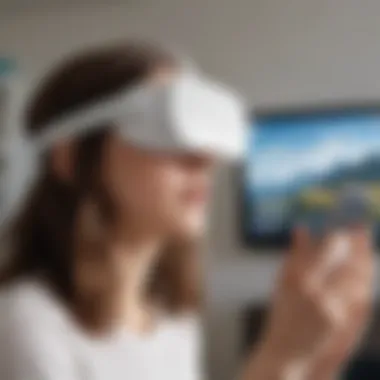An In-Depth Exploration of the Google Daydream VR App


Intro
The world of virtual reality is developing rapidly, and apps such as the Google Daydream VR app are at the forefront of this evolution. This app is designed to enhance virtual experiences, especially for users in the Android ecosystem. It offers a gateway to numerous immersive applications, changing how we play games, attend events, and consume content.
This exploration will dive into various aspects of the Google Daydream VR app. We will examine its functionality, the user experience it provides, and how it sits within the broader context of virtual reality technology. This overview will serve as a valuable resource for avid smartphone users and tech enthusiasts eager to understand this remarkable innovation.
Overview of the Google Daydream VR App
App Intro
The Google Daydream VR app was introduced as part of a broader initiative to make virtual reality accessible to the average consumer. Seen as a significant leap in mobile technology, it allows users to enjoy a wide array of VR content by transforming compatible smartphones into powerful virtual reality devices.
Key Features and Specifications
The Google Daydream VR app has several noteworthy features that set it apart:
- Seamless Integration: The app is designed to work effortlessly with Daydream-compatible devices, providing an integrated experience.
- User-Friendly Interface: It includes an intuitive interface that makes navigation simple, even for beginners.
- Diverse Content Library: A wide selection of games and experiences is available, catering to various interests and preferences.
- High-Quality Graphics: The app takes advantage of the best hardware capabilities in smartphones to deliver stunning visuals.
Pricing and Availability
The Google Daydream VR app is available for free download on the Google Play Store. However, while the app itself is free, access to certain content may require additional purchases. Availability is limited to specific Daydream-ready smartphones, making it necessary for users to check their device compatibility.
In-Depth Review of the Google Daydream VR App
Design and Build Quality
The design of the app emphasizes simplicity and clarity. Screens are organized logically, allowing users to find content easily. The aesthetic is clean, enhancing the overall user experience.
Performance and Hardware
In terms of performance, the Google Daydream VR app is optimized for smooth operation on compatible devices. It utilizes the smartphone's hardware efficiently, providing a lag-free experience while using demanding VR content.
Software Features and User Interface
The user interface of the Google Daydream VR app is highly regarded for its accessibility. Users can view their library, access new apps, and customize settings without difficulty. Features like voice search further enhance usability.
Camera Quality and Imaging Capabilities
While the app primarily focuses on VR content, users benefit from the existing camera capabilities of their devices. This is particularly important for experiences that require input from the camera, such as augmented reality experiences integrated into VR.
Battery Life and Charging
Using the VR app can be taxing on battery life. It is advisable for users to ensure their devices are charged fully before engaging in extended VR sessions to avoid disruptions.
How-To Guides for the Google Daydream VR App
Setting Up the App
To enjoy the Google Daydream VR app, users must first ensure they have a Daydream-ready device, then download the app from the Google Play Store. After installing, the setup process involves connecting VR headsets and configuring settings.
Customization Tips and Tricks
Customization allows for a more engaging user experience. Users can adjust settings such as brightness and volume directly within the app for optimized enjoyment.
Boosting Performance and Battery Life
Keeping the software updated is essential for performance. Additionally, users should close background applications to ensure a smoother VR experience.
Troubleshooting Common Issues
Common issues such as connection problems can often be resolved by restarting the app or the device. Checking for software updates can also mitigate performance-related problems.
Exploring Hidden Features
The Google Daydream VR app includes various features that can enhance user experience. For instance, voice commands can be used to initiate actions quickly, which can be particularly useful during immersive experiences.
Comparison with Competing VR Apps
Spec Comparison with Similar Models
Google Daydream can be compared with other leading VR platforms like Oculus and HTC Vive. Each platform has its strengths and weaknesses. For instance, the Daydream is more mobile-friendly, while Oculus provides a broader range of standalone VR experiences.


Pros and Cons Relative to Competitors
Pros of Google Daydream VR app:
- Ideal for mobile users
- Extensive library of content
- Strong integration with Android devices
Cons of Google Daydream VR app:
- Limited to specific devices
- May not offer as deep an experience as dedicated systems like Oculus Rift.
Value for Money Assessment
The Google Daydream VR app presents a compelling case for value. Given its free access and cost-effective content, it offers a robust entry point into the world of virtual reality for many users.
Prelude to Google Daydream VR
The Google Daydream VR app embodies a pivotal advancement in the realm of virtual reality technology, particularly aimed at enhancing the mobile experience for users of Android devices. The significance of Daydream lies not only in its capabilities but also in its vision of making high-quality virtual reality accessible to ordinary smartphone users. By blending immersive content and a user-friendly interface, Daydream sets a foundation for a myriad of VR applications, thus engaging avid smartphone users and tech enthusiasts alike.
As we delve into the core aspects of Google Daydream, it is essential to appreciate its role in the broader landscape of virtual reality. The integration of VR into mobile devices widens the audience reach, enabling diverse applications ranging from gaming to educational experiences. Daydream stands out by providing a level of compatibility with various devices, ensuring that many users can partake in the virtual experience without requiring high-end hardware.
What is Google Daydream?
Google Daydream is a virtual reality platform launched by Google in 2016 as an upgrade to its previous initiatives in VR. It aims to create an immersive experience that allows users to engage with digital content in ways that traditional screens cannot offer. Users can utilize Google Daydream by pairing compatible smartphones with a dedicated headset and controller, which gives better interaction and navigation within VR environments.
The platform supports a range of applications, from games like "Roller Coaster VR" to apps designed for exploring virtual environments. It emphasizes a balance between quality and accessibility, making VR more inviting for those who may have previously found the technology unfathomable.
Historical Context of VR Technology
To fully understand the significance of Google Daydream, one must consider the historical technology progression leading to its development. Virtual reality as a concept dates back several decades, with early experiments appearing in the 1960s and 1970s. These initial attempts were mainly confined to specialized labs and high-cost setups, limiting accessibility to a small audience.
The advent of more affordable computing power and the rise of smartphones served as a catalyst for mainstream VR adoption. With companies like Oculus and HTC introducing more advanced yet accessible hardware, the demand for consumer-oriented VR experiences soared. Google recognized this trend and aimed to democratize access to virtual realities through Daydream, fostering an environment where both casual users and developers can innovate and enhance the VR landscape.
This context reveals how Daydream is not just a standalone product but rather a continuation of a long-standing quest to merge technology and human experience in immersive ways. The progression of VR technology has created momentum, allowing platforms like Daydream to flourish in an environment ripe for virtual engagement.
Core Features of Google Daydream VR
The core features of Google Daydream VR are fundamental to understanding its role in the virtual reality landscape. They define the user experience and functionality of the app, influencing how users interact with virtual environments. This section will explore significant elements like user interface design, device compatibility, and the variety of supported VR experiences, focusing on their implications and benefits.
User Interface and Design
The user interface (UI) is a crucial aspect of any app, and Google Daydream VR is no exception. It employs a clean, intuitive design that caters to users, regardless of their level of familiarity with VR. The layout allows for easy navigation, making it simple for newcomers to adapt.
Key features of the interface include:
- Card-Based Navigation: Users can easily glide through different VR experiences presented as cards. This feature enhances clarity and simplifies selection processes.
- Easy Access to Settings: The design incorporates user-friendly settings options, enabling modifications without leaving the current experience.
Moreover, the aesthetic of Daydream maintains a sense of immersion while still being visually appealing. This balance is vital in reducing the cognitive load on users, allowing them to engage more deeply with VR content.
Compatibility with Various Devices
Device compatibility is another significant factor that influences the reach and effectiveness of the Google Daydream VR app. Google has made strides to ensure that Daydream works with many Android smartphones, emphasizing the importance of accessibility in the VR space.
Currently, Google Daydream is compatible with devices such as:
- Google Pixel series
- Samsung Galaxy S8 and S9 series
- Lenovo Mirage Solo
These compatibilities allow users to jump into VR experiences without needing to invest in dedicated hardware. However, it is essential to note that not all devices share the same performance capabilities. Users should check for specific requirements to ensure a smooth experience.
Supported VR Experiences
The supported VR experiences within Google Daydream VR are what truly enrich the application. They cover a variety of genres and content types, catering to diverse interests and preferences. This range includes:
- Games: Interactive experiences that provide entertainment and challenge, enhancing user engagement.
- Educational Content: Applications that can transport users to historical events, distant planets, or even the human body. This educational aspect demonstrates VR’s potential for learning.
- 360-Degree Videos: Users can view immersive video content, enhancing the storytelling through an all-around perspective.
This diverse ecosystem demonstrates the commitment to providing quality content that appeals to users with varying interests. The availability of substantial and diverse experiences is a significant drawing feature for potential users.
"Google Daydream VR not only promotes entertainment but also enhances educational and experiential learning."
The core features of Google Daydream VR create a holistic platform that invites users to partake in various experiences, setting the foundation for future innovations in virtual reality technology.
The Content Ecosystem


Understanding the content ecosystem of the Google Daydream VR app is paramount for grasping its relevance in the virtual reality landscape. The app is not just a platform for immersive experiences; it thrives on a rich tapestry of content that shapes user engagement and interaction. This ecosystem encompasses various types of applications, games, and media specifically designed to leverage Daydream's unique capabilities, catering to both entertainment and educational purposes.
The importance of a diverse content ecosystem cannot be overstated. It serves as a driving force behind user adoption and retention. When users access a wealth of compatible and captivating experiences, they are more likely to spend time within the app, leading to higher satisfaction and loyalty. An impressive range of available content also encourages new users to adopt the platform, as they see tangible benefits from the outset.
Types of Available Content
Google Daydream boasts an extensive library of content tailored to exploit its VR capabilities. The primary types include:
- Games: Engaging, interactive experiences designed for entertainment often utilize motion controls and immersive environments. Titles like "Mortal Blitz" and "Headmasters" exemplify the potential for dynamic gameplay.
- Educational Applications: These apps focus on providing knowledge and skills in subjects such as science, history, and art. Platforms like "Tilt Brush" allow users to create 3D art in a virtual space, merging creativity and education.
- Social Experiences: Applications such as "Bigscreen Beta" let users socialize in virtual environments, watching movies or playing games together even if they are miles apart.
- Experience-based Content: This category includes virtual tours of real-world locations, enhancing learning through engagement. Apps like "Google Earth VR" help to provide geographical and cultural education through immersive experiences.
These varied forms of content contribute to Daydream's attractiveness, as they cater to a broad spectrum of interests and preferences among users.
Content Creation and Developers
The role of content creators and developers within the Daydream ecosystem is critical. They are the architects of experience and engagement, responsible for generating innovations that enrich the platform. Many independent developers find the Daydream platform accessible, often citing ease of creating content compared to other VR systems.
Popularity encourages a competitive environment where quality and creativity flourish. As developers release new content, users can enjoy fresh experiences, thus revitalizing their interest in the platform. Major studios such as Ubisoft and Electronic Arts contribute heavily to the content library, while smaller studios often carve niches with unique ideas and styles.
In addition to game design and applications, the broader community contributes by sharing tips and tutorials. Platforms like Reddit facilitate discussions around troubleshooting and best practices for content creation. This community-driven effort helps sustain Daydream's ecosystem, allowing it to evolve continuously.
"The success of any VR platform largely depends not only on hardware but also on the content that brings it to life."
In summary, the content ecosystem of Google Daydream VR plays a vital role in user satisfaction and platform longevity. A rich array of content options, alongside active community participation in creation and support, cements Daydream's position in the virtual reality market. Understanding this ecosystem is essential for comprehending the full scope of what Google Daydream VR has to offer its users.
User Experience and Interface
User experience and interface design play a critical role in the overall acceptance of any technology, particularly in virtual reality systems like Google Daydream VR. The interaction between the user and the app shapes how effectively users can navigate immersive environments, access content, and utilize various functionalities without feeling overwhelmed or confused. A well-designed user interface not only enhances usability but also significantly impacts the enjoyment and satisfaction of the user.
One of the foremost aspects of the user experience in Daydream is the intuitive navigation. Users are greeted with a simple home screen, which provides easy access to various apps and experiences. This straightforward approach minimizes the cognitive load on users, allowing them to focus on exploration and immersion. The controls are designed to respond fluidly to gestures and touch, promoting a natural interaction model that feels comfortable. This aspect is crucial, especially for first-time users, as it encourages them to explore without the fear of technological complications.
Another vital element is the customization of user settings. Daydream allows users to tailor their experience according to their preferences. This includes options for adjusting visual settings, adjusting sound quality, and managing comfort features. Customization options enhance user satisfaction, making the environment not just a tool, but a personal space. The balance between simplicity in navigation and flexibility in settings stands out in Daydream, fostering a more meaningful engagement.
"User experience in VR is not just about making things look good; it's about creating an environment where users can feel comfortable and engaged."
Furthermore, user feedback mechanisms integrated within the app also contribute to its usability. Various forums and communities, such as the conversations on Reddit ( Reddit), allow users to share their thoughts and experiences about Daydream. This aspect not only helps Google understand user satisfaction but also supports a community atmosphere that can lead to more updates and features aligned with users’ desires. Feedback is pivotal as it helps refine the app's interface and discover areas needing improvement.
Navigating the VR Environment
Navigating the Google Daydream VR environment is a crucial part of the user experience. A user’s journey in this virtual landscape starts with the headset, which should fit comfortably and securely. This ensures that the user remains engaged without distractions from the physical limitations of the device. Once the headset is on, navigating through various apps and experiences unfolds via a combination of gaze and controller input. The ease of moving through 360-degree environments speaks to the platform's design philosophy that values intuitive interaction.
The Daydream interface employs a point-and-click style, where the user looks at an icon and clicks to select. This design minimizes the need for extensive hand movements, providing a seamless experience. Users can also access a variety of content ranging from games to educational experiences, all designed to take full advantage of the VR environment. The layering of information and controls is well thought out, allowing users to transition smoothly from one task to another.
To enhance accessibility, Google incorporates tutorial segments that introduce users to features and navigation techniques. New users benefit from these introductory guides, which further lower the entry barrier to VR experiences. Additionally, visual cues and prompts help guide users through the system, ensuring they can find what they want without excessive search time.
Real-World Applications
The applications of Google Daydream VR extend beyond gaming and entertainment, influencing various fields in real ways. Education is one area where VR can be transformative. Through immersive simulations and virtual field trips, users can have experiences that traditional learning environments cannot provide. For instance, students can explore historical sites or engage in complex science experiments safely and interactively. This application not only enhances learning but also supports retention of information better than conventional methods.
Healthcare is another sector benefiting from virtual reality technologies. Medical professionals can use Daydream to simulate patient interactions or practice surgical procedures in a risk-free environment. This hands-on approach empowers them to refine their skills with confidence, improving patient care and outcomes.
Moreover, in the realm of real estate, Daydream VR allows potential buyers to tour properties without leaving their homes. This capability streamlines the buying process and enhances customers’ understanding of spaces.
Finally, training programs in various industries leverage VR for employee onboarding and skill development. The immersive setups not only engage employees but also encourage better retention of necessary knowledge and organizational procedures. The possibilities for real-world applications of Google Daydream VR are virtually limitless, showcasing its potential to reshape how we interact with technology on a daily basis.
Comparative Analysis with Other VR Platforms
The discussion surrounding Google Daydream VR transcends mere gadgetry; it encapsulates the broader themes of technological advancement in the realm of virtual reality. A comparative analysis with other VR platforms is vital. This section delves into specific elements, benefits, and considerations that highlight how Google Daydream holds its own against competitors like Oculus and HTC Vive. It allows users and enthusiasts understand the varying strengths and weaknesses each platform brings to the table.
Daydream vs. Oculus and HTC Vive
When it comes to immersiveness, Oculus and HTC Vive traditionally dominate the VR landscape. These platforms are rooted in high-end hardware that supports elaborate virtual environments. Oculus, with its various models, offers integrated tracking and a robust ecosystem. Similarly, HTC Vive pioneers room-scale VR that enhances user interaction, placing users in the center of the action. Both systems provide exceptional visual quality, but they come with steep price tags and require extensive setup.
In contrast, Google Daydream centers its approach on accessibility and ease of use. Designed for mobile, it operates through compatible smartphones. This immediacy appeals to casual users but raises concerns about quality. The graphics and performance cannot quite match the fidelity achieved by powerful rigs like those required for Oculus or HTC Vive.
Several critical points can be noted in this comparison:
- Price Accessibility: Daydream's mobile orientation allows a wider range of users to experience VR without the financial burden of high-end PCs or consoles.
- Setup Complexity: Unlike the Vive's intricate setup, Daydream functions with minimal configuration, thanks to its reliance on smartphones.
- Content Availability: Each platform has unique content. Oculus and Vive offer more extensive, graphically rich experiences, while Daydream has a smaller but diverse library of games and applications.
"While Oculus and HTC Vive are leaders in immersive experiences, Google's focus on mobile VR opens doors for a broader audience, making VR more approachable."
Unique Selling Propositions of Daydream


Google Daydream presents several unique selling points that make it a compelling choice within VR. Notably, its integration with Android is a standout feature. This enhances functionality and allows seamless interaction with a user's existing smartphone ecosystem.
The Daydream View headset further extends its appeal. Lightweight and comfortable, it offers a portable solution that is easy to wear for extended periods. Here are additional points that emphasize Daydream's unique strengths:
- User-Friendly Interface: The app’s interface is designed for straightforward navigation, lowering the learning curve required for first-time users.
- Broad Compatibility: Daydream is compatible with a range of devices, enhancing its accessibility.
- Diverse Content Selection: Although the library is smaller than that of its competitors, it includes a varied catalog of genres, appealing to multiple interest groups.
Challenges Faced by Google Daydream VR
The exploration of Google Daydream VR would be incomplete without considering the hurdles that the platform faces. These challenges are significant as they shape the overall user experience and the future sustainability of the technology. It is essential to analyze both the technical limitations and the market competition that affect Daydream VR's position in the virtual reality landscape.
Technical Limitations
One primary challenge for Google Daydream VR is its technical limitations. While the platform offers an immersive experience, it is often constrained by hardware capabilities. Many Daydream-compatible devices may not provide the high refresh rates or low latency required for a seamless experience. Performance issues can lead to motion sickness, which is detrimental to user satisfaction. Additionally, some users report a lack of intuitiveness in the interface, making navigation less straightforward than anticipated.
Moreover, the reliance on mobile devices for processing can hinder the overall capability of the Daydream app. The graphical fidelity is often not as high as found in more powerful systems like the Oculus Rift. This distinction can alienate users who seek out top-tier VR experiences.
Market Competition
The market competition for Google Daydream VR represents another intricate challenge. It must contend with established brands like Oculus and HTC Vive, which have already carved out major market shares in the VR space. These companies have strong ecosystems, offering a diverse range of hardware and software solutions. The extensive library of content on platforms like Oculus provides a competitive edge that Daydream struggles to match.
The rise in popularity of standalone VR headsets has also intensified competition. Unlike Daydream, these devices do not require a smartphone and offer an all-in-one solution, appealing to new users who might find the setup of Daydream cumbersome.
"With the advancements in VR technology, the battle for user minds is fiercer than ever. Products must not only deliver performance but also simplicity and availability."
The Daydream VR app is at a crossroads. It must address these challenges by innovating its technology and enhancing market presence. Without new features and improvements, Daydream risks being overshadowed by its competitors, leaving devoted smartphone users and tech enthusiasts looking for better alternatives. Understanding these challenges illuminates the road ahead for Daydream VR and its potential impact on virtual reality technology.
Future of Google Daydream VR
The future of Google Daydream VR is pivotal not just for its continued development, but for the entire landscape of virtual reality. As technological advancements proceed, the expectations of users are evolving too. This section will discuss upcoming features, future updates, and the implications of these developments in the VR space. Understanding these elements is crucial for tech enthusiasts and average smartphones users alike.
Upcoming Features and Updates
Google Daydream VR is in a constant state of evolution. Upcoming features aim to enhance user experience significantly. The integration of advanced tracking technology can be on the forefront of these updates. Improvements in motion tracking will lead to a more immersive and responsive VR environment.
Additionally, streamlined updates may focus on optimizing the performance of the app across a range of devices. As the app grows, Google could enhance resolution and graphic fidelity, which are central to a captivating experience. There are rumors of introducing support for augmented reality features, merging VR with elements from the real world in new, innovative ways.
These advancements will not only improve user experience but also drive more developers to create exclusive content for Daydream. The community will play a significant role, providing feedback and suggestions to shape the future updates.
Implications for Virtual Reality Technology
The implications of Google Daydream VR extend beyond its core features. As the app's capabilities grow, they can set new standards in virtual reality technology. With potential advancements such as 6DoF tracking and higher-quality graphics, it pushes competitors in the VR space to innovate. This kind of competition can lead to faster technological advancements across all platforms, ensuring that VR technology continues its upward trajectory.
Furthermore, as more users engage with Daydream, it may help broaden the general appeal of VR in everyday life. This makes VR more than a niche market, impacting sectors such as education, healthcare, and entertainment.
User Feedback and Community Insights
Understanding user feedback and community insights is essential in evaluating the Google Daydream VR app. This information plays a pivotal role in shaping the future direction of the application, impacting both current and prospective users. Collecting various user perspectives allows developers to pinpoint strengths and weaknesses, enabling more user-centered improvements.
Gathering User Experiences
Gathering user experiences is about collecting feedback from individuals who have directly interacted with the Google Daydream VR app. This can include reviews on app stores, user forums, and social media platforms. Users share their thoughts on factors such as usability, performance, and overall satisfaction. Analyzing this data helps identify common issues users face, from compatibility problems with devices to bugs plaguing specific features.
One key aspect is the importance of diverse feedback. Users come from different backgrounds with varying levels of technology comfort. Experienced users may use advanced functionalities, while casual users might focus on ease of use.
This diversity in feedback leads developers to gain insights that cater to a broad range of customers. Such insights can directly influence decisions on updates and enhancements, ensuring the app better meets user needs.
Community Contributions
Community contributions refer to the collaborative efforts made by users to improve the Google Daydream VR experience. Many virtual reality enthusiasts actively participate in forums or discussion groups where they exchange tips, tricks, and experiences. Notably, platforms like Reddit or specialized Facebook groups can serve as vital hubs for community interaction.
These contributions not only enhance user knowledge but can also help resolve problems faster. For instance, if a common issue arises, users might share their solutions, fostering a sense of community. Moreover, developers often listen to these discussions to identify trends in user sentiment, which can be crucial for improving the app.
"User feedback shapes the evolution of technology. Understanding the community's voice is not a mere step; it is a necessity for growth."
Furthermore, active engagement within the community can attract new users. When potential users see a vibrant, supportive community, they may feel more inclined to adopt the Google Daydream VR app. An engaged user base often reflects positively on the app itself, increasing its overall credibility in a highly competitive field.
The End
The conclusion serves as a critical juncture in our exploration of Google Daydream VR. It encapsulates the findings, insights, and implications gathered throughout the article. The importance of this section lies in its ability to summarize the unique aspects of Google Daydream VR and emphasize its role within the broader context of virtual reality technology.
Summarizing the Impact of Google Daydream VR
Google Daydream VR has wielded significant influence on how virtual reality applications are perceived and utilized. It has made strides in optimizing user experience through an intuitive interface that welcomes both novice users and seasoned enthusiasts. By providing access to a variety of content, Google has effectively fostered a diverse ecosystem where developers can thrive, thus encouraging innovation.
Moreover, Daydream's emphasis on mobile compatibility illustrates a pivotal shift towards accessible virtual reality. It allows users to immerse themselves in rich experiences without requiring expensive equipment. This accessibility is vital as it expands the potential user base, enabling a wider audience to engage with VR technologies. In summary, the impact of Google Daydream VR is profound, shaping not only user habits but also informing the direction of future developments in the VR landscape.
Final Thoughts on the Future of VR Apps
Looking ahead, the landscape of virtual reality apps appears promising yet complex. With evolving technological advancements, the demand for more immersive and sophisticated experiences will continue to grow. Google Daydream VR, as a trailblazer in this arena, is poised to adapt and evolve with these demands. Upcoming features, as hinted in industry discussions, may usher in new levels of interactivity and realism that will set new benchmarks.
Moreover, the dialogue surrounding user feedback and community involvement is essential. As users express their needs and suggestions, developers will likely respond, refining and evolving the app accordingly. This interplay between users and developers will cause a dynamic growth in VR applications overall. Therefore, the future of VR apps, with Daydream as part of the narrative, could reshuffle our understanding and engagement with both technology and entertainment.



